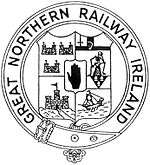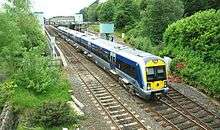Great Northern Railway (Ireland)
 | |
| Industry | Rail transport |
|---|---|
| Fate | Dissolved |
| Predecessor |
Irish North Western Railway Northern Railway of Ireland Ulster Railway |
| Successor |
Ulster Transport Authority Córas Iompair Éireann |
| Founded | 1876 |
| Defunct | 1958 |
| Parent | Great Northern Railway Board |
The Great Northern Railway (Ireland) (GNR(I) or GNRI) was an Irish gauge (1,600 mm (5 ft 3 in)) railway company in Ireland.
The Great Northern was formed in 1876 by a merger of the Irish North Western Railway (INW), Northern Railway of Ireland, and Ulster Railway. The Ulster Railway was the GNRI's oldest constituent, having opened between Belfast and Lisburn in 1839 and extended in stages to reach Clones in 1863. The Northern Railway of Ireland was itself formed by a merger of the Dublin and Drogheda Railway (D&D) with the Dublin and the Belfast Junction Railway (D&BJct).
The Ulster, D&D and D&BJct railways together formed the main line between Dublin and Belfast, with the D&BJct completing the final section in 1852 to join the Ulster at Portadown. The GNRI's other main lines were between Derry and Dundalk and between Omagh and Portadown. The Portadown, Dungannon and Omagh Junction Railway together with the Londonderry and Enniskillen Railway enabled GNRI trains between Derry and Belfast to compete with the Belfast and Northern Counties Railway, and both this and the Dundalk route gave connections between Derry and Dublin. These main lines supported the development of an extensive branch network serving the southwest half of Ulster and northern counties of Leinster. The GNRI became Ireland's most prosperous railway company and second largest railway network.

In its early years the GNR(I) closely imitated the image of its English namesake, adopting an apple green livery for its steam locomotives and a varnished teak finish for its passenger coaches. Later the company adopted its famous pale blue livery for locomotives (from 1932), with the frames and running gear picked out in scarlet. Passenger vehicles were painted brown, instead of varnished.
Growth and partition

In the early 20th century increasing traffic led the GNRI to consider introducing larger locomotives. The Great Southern and Western Railway had introduced express passenger locomotives with a 4-6-0 wheel arrangement, and the GNRI wanted to do the same. However, the lifting shop in the GNRI Dundalk works was too short to build or overhaul a 4-6-0, so the company persisted with 4-4-0 locomotives for even the heaviest and fastest passenger trains. This led to the GNRI to order a very modern and powerful class of 4-4-0's, the Class V three cylinder compound locomotives built by Beyer, Peacock in 1932. This class has been compared with another notable V class, that introduced by the Southern Railway in England in 1930.
The Partition of Ireland in 1921 created a border through the GNRI's territory. The new border crossed all three of its main lines and some of its secondary lines. The imposition of border controls caused some service disruption, with main line trains having to stop at both Dundalk and Goraghwood stations. This was not eased until 1947 when customs and immigration facilities for Dublin–Belfast expresses were opened at Dublin Amiens Street station (renamed Dublin Connolly in 1966) and Belfast Great Victoria Street station.
Nationalisation and division
.jpg)
A combination of the increasing road competition facing all railways and a change in patterns of economic activity caused by the partition of Ireland reduced the GNRI's prosperity. The company modernised and reduced its costs by introducing modern diesel multiple units on an increasing number of services in the 1940s and 1950s and by making Dublin–Belfast expresses non-stop from 1948. In Dundalk at the GNR Works the railway engineers developed railbuses for use on sections of the rural network.[1] Nevertheless, by the 1950s the GNRI had ceased to be profitable and in 1953 the company was jointly nationalised by the governments of Ireland and Northern Ireland. The two governments ran the railway jointly under a Great Northern Railway Board until 1958.

In May 1958 the Government of Northern Ireland's wish to close many lines led to the GNRI Board being dissolved and the assets divided between the two territories. All lines in Northern Ireland were transferred to the (nationalised) Ulster Transport Authority (UTA) and all lines in the Republic of Ireland were transferred to Córas Iompair Éireann (CIÉ). CIÉ had been formed as a private company in 1945 but had been nationalised in 1950. In an attempt at fairness, all classes of locomotive and rolling stock were also divided equally between the transport operators of the two new owners. Most classes of GNRI locomotive had been built in small classes, so this division left both railways with an operational and maintenance difficulty of many different designs all in small numbers.
The Northern Ireland Government, which had a very anti-rail policy, rapidly closed most of the GNRI lines in Northern Ireland.[2] Exceptions were the Belfast–Dundalk and Portadown–Derry main lines and the Newry–Warrenpoint and Lisburn–Antrim branches. It made the Lisburn–Antrim branch freight-only from 1960 and closed the Portadown–Derry and Newry–Warrenpoint lines to all traffic in 1965.[3] The Republic of Ireland government tried briefly to maintain services on lines closed at the border by the Northern Ireland government, but this was impractical, and the Republic had to follow suit in closing most GNRI lines south of the border. Since 1960 the Drogheda–Navan branch has survived for freight traffic only.
CIÉ also acquired the Hill of Howth Tramway, in the northern suburbs of Dublin, in the 1958 dissolution of the GNRI Board. CIÉ closed the tramway about a year later.
Today, the GNR routes remaining consist of the main line from Dublin to Belfast, the Howth branch, electrified for Dublin commuter services since 1984, the Drogheda - Navan (Tara Mines) line, which carries only freight traffic associated with that mine, passenger traffic having ceased with the closure of the line beyond there to Oldcastle in 1963, and the Lisburn to Antrim branch, now mothballed but retained in operational order for the time being.
Accidents and incidents
- On 12 June 1889, a passenger train stalled between Armagh and Newry. The train was divided, but during the uncoupling operation ten carriages ran away and collided with another passenger train. A total of 80 people were killed and 260 were injured in what was then the deadliest railway accident to have occurred in Europe. As of 2016, the accident remains the deadliest to have occurred on the island of Ireland.
The Fintona horse tram
The GNR's north western main line between Dundalk and Derry bypassed the small County Tyrone town of Fintona, which was instead served by a 1 mile (1.6 km) branch line from Fintona Junction station. The service was operated by the double-deck Fintona horse tram until the line's closure in 1957.
Preserved vehicles

Four GNRI steam locomotives are preserved. The Railway Preservation Society of Ireland at Whitehead owns two of its 4-4-0's (one each of classes S and Q) and has custodianship of a third 4-4-0, (V class) which is on loan from the Ulster Folk and Transport Museum at Cultra. The RPSI periodically operates one or more of them on special excursion trains on Northern Ireland Railways and Iarnród Éireann (successor to CIÉ) routes. A 2-4-2T (JT class) locomotive is preserved at the Ulster Folk and Transport Museum at Cultra.
Some of its coaching stock has also been preserved. 1938 built dining car No.88 still sees use as part of the Railway Preservation Society of Ireland's Dublin based "heritage set" of coaches. Also operating in this set is a 1954 built brake coach No.9, although it currently carries the number 1949.[4] The Downpatrick & County Down Railway also has an example of a third-class GNR six-wheeled carriage, in an unrestored condition.[5]
- Steam Locomotives: V Class No. 85 (UFTM), S Class No. 171 (RPSI), Q Class No. 131 (RPSI), JT Class No. 93 (UFTM)
- Tenders: No. 31 (RPSI), No. 43 (RPSI)
- Carriages: Directors Saloon No. 50 (RPSI), Open Third No. 114 (RPSI), Dining Car No. 88 (RPSI), Open Third No. 1949 (RPSI), Unidentified 6-Wheeler (DCDR)
- Wagons: Parcel Van No. 788 (RPSI), Brake Van No. 81 (RPSI), Grain Vans No.'s 504 & 2518 (RPSI), Crane No. 3169 (RPSI), Ballast Wagon No. 8112N (RPSI), Unidentified Open Wagon (RPSI), Unnumbered Boiler Wagon (RPSI)
- Railbuses: AU345 (C&L), E (UFTM)
- Trams: Fintona No. 381 (UFTM), Howth No. 2 (UFTM), Howth No. 4 (OERM), Howth No. 9 (NTMI), Howth No. 10 (NTM)
- Road Vehicles Bus No. 289 (C&L), Bus No. 390 (NTMI), Bus No. 438 (NTMI), Lorry No. 150 (NTMI)
Historic Buildings
There are a number of historic buildings built by the GNRI such as Lisburn and Dundalk.
In 2011, a former GNR Signal Cabin from Bundoran Junction arrived at the Downpatrick and County Down Railway. The cabin was installed on the platform at Downpatrick railway station in October 2015, where it is to be restored to working order.
References
- ↑ Rail buses developed at Dundalk GNR Works - Independent.ie
- ↑ The closures started several years before the Beeching cuts, which implemented widespread rationalisations of the railway network in Britain.
- ↑ "Closure of the 'Derry Road' a great loss to Ireland - Derry Journal". Retrieved 2013-08-20.
- ↑ The Railway Preservation Society of Ireland: Heritage Carriages (Dublin) Retrieved 05-05-2015
- ↑ "GNRI Six-wheeler (body only)". Cs.vintagecarriagestrust.org. Retrieved 2011-08-11.
Further reading
- Anonymous (1947). GNR(I) Bye Laws and Regulations. Dublin: The Great Northern Railway.
- Arnold, Robert M. (1983) [1979]. The Golden Years of the Great Northern Railway. Part 1. Belfast: The Blackstaff Press. ISBN 0-85640-182-X.
- Arnold, Robert M. (1986) [1980]. The Golden Years of the Great Northern Railway. Part 2. Belfast: The Blackstaff Press. ISBN 0-85640-126-9.
- Ferris, Tom (2003). The Great Northern Railway: An Irish Railway Pictorial. Shepperton: Midland Publishing. ISBN 1-85780-169-5.
- FitzGerald, J.D. (1995). The Derry Road. Colourpoint Transport. Gortrush: Colourpoint Press. ISBN 1-898392-09-9.
- Flanagan, Colm (2003). Diesel Dawn. Newtownards: Colourpoint Books. ISBN 1-904242-08-1.
- Johnston, Norman (2005). The Great Northern Railway (Ireland) in Colour. Colourpoint Transport. Gortrush: Colourpoint Press. ISBN 1-904242-36-7.
- Johnston, Norman (1991). The Great Northern Railway in County Tyrone. West Tyrone Historical Society. ISBN 0-9517175-0-2.
- Murray, Kevin (1944). The Great Northern Railway (Ireland) Past Present & Future. Dublin: The Great Northern Railway.
- Patterson, Edward M. (2003) [1962]. The Great Northern Railway (Ireland). Lingfield: Oakwood Press. ISBN 0-85361-602-7.
- Patterson, Edward M. (1986) [1962]. Great Northern Railway of Ireland. Oakwood Library of Railway History. Lingfield: Oakwood Press. ISBN 0-85361-343-5.
- Smith, C.M.; Curran, B.L. (December 1969). "Bundoran Reflections" (PDF). Five Foot Three. Railway Preservation Society of Ireland (9).
External links
| Wikimedia Commons has media related to Great Northern Railway (Ireland). |
- Great Northern Railway Architecture at Archiseek.com
- Irish Railway Record Society: Irish Railways: 1946 - 1996; Great Northern Railway (Ireland)
